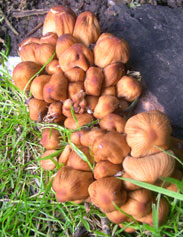Honey Fungus (Armillaria mellea)
Posted by Fiona Nevile in General care | 14 comments When I arrived at the cottage 15 years ago as a novice gardener, I discovered Honey Fungus. It was a bit of a blow. The name Honey Fungus sounds so gentle. It is not. Even then I knew that Honey fungus can decimate the shrubs and trees in a garden. Its progress is relentless, young shrubs and trees or old ones that are weak and diseased are most susceptible. Honey fungus is the MRSA of the garden.
When I arrived at the cottage 15 years ago as a novice gardener, I discovered Honey Fungus. It was a bit of a blow. The name Honey Fungus sounds so gentle. It is not. Even then I knew that Honey fungus can decimate the shrubs and trees in a garden. Its progress is relentless, young shrubs and trees or old ones that are weak and diseased are most susceptible. Honey fungus is the MRSA of the garden.
I had bought a cottage with a field garden, with minimal planting. What was I to do?
If you discover Honey Fungus in your garden there are ways to treat and try and contain it, although in the end you have to accept that if you have it, it is probably in nearby gardens and it will return. The first thing to do is to familiarise yourself with how it looks. There are the mushrooms, and the “black bootlaces” that grow beneath the ground and spread the disease.
Initially I just removed the mushrooms and treated infected trees and shrubs with Armillatox and had some success with this. Then I planted Honey Fungus resistant hedging – the yew and the box. I also planted beech hedging and the trees and shrubs that I wanted even though they were not resistant.
All was well for a couple of years and then three old apple trees (these are very susceptible) in the orchard area started to die off. All good croppers and sadly missed. Since then, I would see the mushrooms beside an occasional shrub and within a year or so the shrubs would die. In the end I decided I was fighting a losing battle and gave up battling with the disease. The woods beside the garden are full of Honey Fungus.
When I saw the Honey Fungus mushrooms back in June 2007. My heart sank. I started to do more research and found this useful site. Although I didn’t take his advice fry the mushrooms in a little butter, I have been following the instructions outlined in the article and applying the wood ash tonic. So far so good. Suddenly I am being much more proactive on the Honey Fungus front and feeling much better about it. Using this method of boosting the garden’s defences is the route that I will be taking from now on.
I have also treated all the fruit trees that I have planted even though they show no signs of the disease.
Leave a reply





Would you consider introduction of probiotic/anti fungal gut treatment Syntol AMD–capsules probably mixed in water and poured about root structures? I will likely loose an acre or so of 40 year old woody plants and trees if we can’t come up with something. If probiotics can tackle the human gut, why not root rot?
Sounds simplistic to me. Dealing with single celled yeast organisms in the confined space of a human gut is not the same as dealing with a complex fungus that is running rampant in the soil over a large area of land. The fundamental question may be what imbalance is causing (allowing/facilitating?) the honey fungus to run amok in your plantation? Looking at ways to get your soil into a better state of health and balance might be a better way to go. I suspect biodynamics are more likely to provide solutions than quack doctoring.
I spent ages trawling through all my gardening books and found nothing about Honey Fungus. Thank you for your site and warnings. Yes, I have just discovered it on a rather old Buddleja tree, so must keep a close eye on my fruit trees.
We are witnessing the sad death of our much-loved garden from honeyfungus – I’ve decided to feed everything with the wood ash tonic, and leave it a couple of years before I replant anything to see what shape will result from the devastation (most things we have are susceptible).
In the meantime, does anyone know the effects on the vegetable garden? I’ve discovered that potatoes and strawberries are susceptible, but what about root veg, brassicas, onions, salads and peas and beans?